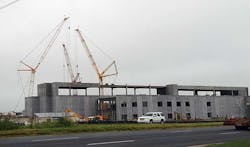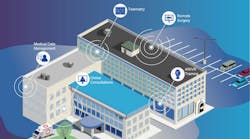Zech Connell, Project Development at ProLift Rigging Co., shares insight into the importance of project buffering between equipment procurement and installation in the ever-increasing data center construction race to market.
Zech Connell, Project Development, ProLift Rigging Co.
The Cost of Doing Business
I recently read an interesting construction case study by the U.S. Chamber of Commerce that discussed the breakdown of data center capital expenditure construction phases during the initial (land acquisition) and development (shell building, electrical and mechanical equipment procurement) to installation (building fit-out). The study sampled over 200 large colocation and enterprise data centers from the 10 largest service and enterprise providers in the United States and concluded their initial capital costs totaled over $8.2 billion.
The study showed that, on average, 6% of that $8.2 billion in initial capital expenditures went towards land acquisition, 21% towards civil and building shell, and a whopping 73% towards purchasing and fitting out the building with mechanical and electrical equipment. And on some major sites, equipment costs ranged between 82-85% of total initial capital investment. For the non-data center construction professionals, that’s a large capex on equipment, i.e. generators, air-conditioning units, transformers, chillers, power distribution units, transfer switches, uninterruptable power supply systems, etc. These infrastructure cost breakdown percentages obviously vary based on your data center size, location, and infrastructure tier requirements, but they are thought-provoking, to say the least.
The law of supply and demand, and the ever-changing regulatory requirements, clearly contributes to the growing equipment capex, but onsite skilled labor contracted to install the equipment is a significant contributing factor. In fact, the American Society of Professional Estimators concluded that out of the 82-85% of initial capital investment on equipment procurement and installation, the equipment purchase accounted for only 25%, and the onsite skilled labor accounted for 75%. That’s staggering.
Inefficiency is Expensive
The most expensive controllable cost for your data center construction site is the skilled onsite labor, especially when site inefficiencies exist. Some major projects could be spending over $60,000 per hour for 500 skilled tradespeople during peak construction. That is $600,000 for a standard 10-hour day for 500 tradespeople. Expense can add up quickly and drastically damage your project’s bottom line if your project isn’t operating at maximum efficiency.
Remember though, your planned site is just a small piece to the booming data center construction market, and you run a high risk of becoming lost in the demand, like the northeastern project, if proper buffering isn’t allocated to your schedule.
When is the last time you remember waiting for a generator or major component to arrive from the manufacturer according to the planned just-in-time delivery schedule? Did it arrive on time? From our experience, we would bet the house on no. Ensuring your project teams are efficient and productive, and that you are not paying for unnecessary labor, means eliminating wait times on equipment deliveries and the need to constantly revise the three day lookahead to account for the inevitable equipment delays. Site inefficiency is the single largest variable for cost increases on a construction build.
Unfortunately, we at ProLift have witnessed the problem of costly inefficiency countless times as we’ve had the privilege of serving the data center market in transportation, storage, and installation of mechanical and electrical equipment. We have worked on many of the largest and most complex data center sites in the United States and understand that no project is immune to the effects of an inefficient process. “Synchronizing the original equipment manufacturers’ (OEM) production and site delivery dates with your critical construction project activities is a challenge,” said Matt Brennan, ProLift President. “OEMs have an ever-increasing demand to produce high quantities of equipment in a short amount of time and then move it off their production line as soon as possible. This often leaves our customers in a very difficult position due to issues with site readiness and inflated emergency storage costs.”
Two Projects, Two Outcomes
In 2019, we had the pleasure of working on a large data center project in the northeastern United States. Top notch client with dedicated and knowledgeable team partners. While the plan was set for a smooth project, it was ultimately delayed two months with dedicated construction resources onsite, including our ProLift team. The delay was due to various equipment not being delivered on time and ended up doubling the scheduled completion time.
Conversely, we also recently worked on another data center project in the southeastern United States. Again, top notch client with dedicated and knowledgeable team partners. This team took a more proactive approach to avoid inefficiencies by allowing us to partner with them utilizing our Project Buffering approach. We ended up receiving and warehousing the equipment as soon as it was ready from the manufacturer while the building construction phase continued to progress. Once the building was completed, we were able to transport and set our entire electrical scope in a short span. The client not only avoided costly delays but also met all scheduled project deadlines.
The northeastern project issue was caused by the manufacturers inability to produce the required equipment, due to high demand, in the amount of time agreed upon which caused the costly two-month schedule delay with dedicated resources onsite. The southeastern project’s use of Project Buffering allowed us to set the entire generator yard and indoor electrical line ups in a short twenty-day span, compared to the three-month planned schedule, placing them ahead of schedule and under budget. Two similar projects in size and planned duration with significantly different outcomes due to the utilization of Project Buffering.
Growth Requires a Proactive Approach
According to a recent datacenter Hawk report, as of Q4 2019, we have 6,000 MW of planned power and almost 36,000,000 square feet of planned space in the top ten United States data center markets alone. We are living in exciting times and have a lot to look forward to. Remember though, your planned site is just a small piece to the booming data center construction market, and you run a high risk of becoming lost in the demand, like the northeastern project, if proper buffering isn’t allocated to your schedule.
Zech Connell is Project Development at ProLift Rigging Co.





